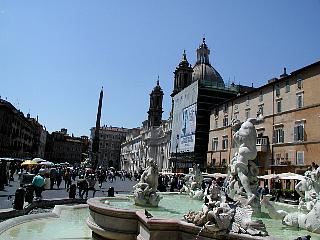 |
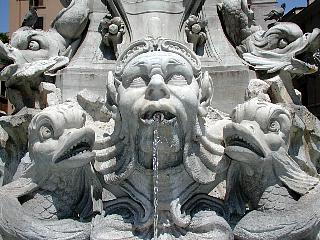 |
Last night, the fellow at the hotel's desk told us that there'd be a
shuttle from the hotel to the starting point for the hop-on, hop-off tour
bus. This morning, the location mysteriously changed to Barbarini square.
So off we went, with pretty much no clue as to where in the square the
bus would actually stop. After several failed attempts at calling the bus
company, and a few attempts at asking the locals, we thought we knew where
the bus stopped (the hotel desk already 'told' us, but at this point he
was batting 0.000, so we didnt really trust the information. After about
an hour of waiting, a bus that fit the description stopped in the spot
we'd identified, so we hopped on, only to be told it was the wrong bus.
As we got off, we saw the right one driving past, stopping at a traffic
light. I chased after it, flagged it down, and we got on. I asked, and
it turned out the guy at the hotel had given us a location closer to the
correct one than where we we'd been waiting, but still not on target.
 |
 |
Our first destination was going to be the stop for Piazza Navona and
The Pantheon. While Piazza Navona offered some interesting photo ops, The
Pantheon was by far the more compelling. Again, photos and descriptions
of these landmarks really doesn't do justice to their maesty there are
plenty of tour books that provide both. To get the full effect, you have
to be there. As it was a sunny day around noon when we arrived, the opening
atop the pantheon cast a beam of sunlight below, like a spotlight. A nice
piece of ancient engineering.
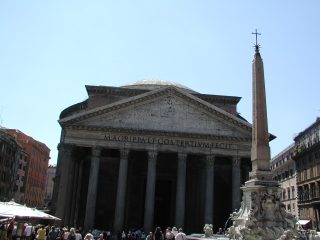 |
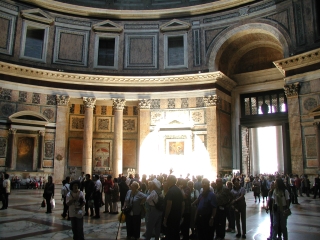 |
Being Jewish, I'm not completely sure why I felt compelled to make this
visit perhaps just to see what all the fuss is about. But I'm surely
glad we did the inside of the Basilica really is overwhelming. The few
photos I took inside the Basilica don't begin to do justice to either the
art or the experience... but take a look anyway.
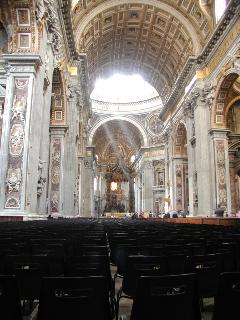 |
 |
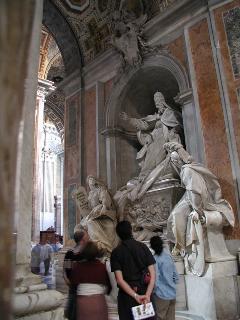 |
Much of our conversation ran to how places like this must have contributed to the rise of Christianity in its earlier days the idea of being part of something of this immensity would have been a powerful draw.
Afterward, through a separate entrance, we were able to ascend to the top of the cupola atop the Basilica. The signs warn of a climb of 340 steps *after* the elevator ride, and advice against it being attempted by the fat, lazy, or feeble (they worded it a bit more diplomatically, of course). We went for it.
At about 30 steps beyond the elevator, there was an opportunity to walk
a catwalk that runs the perimeter of the inside of the cupola, looking
down on the interior of the Basilica. What a view! You could also look
up from there to the painting inside the cupola. The next 310 or so steps
are mostly through cramped spiral staircases, surrealistically distorted
staircases between the inner and outer walls of the dome, and zig-zaggy
narrow corridors, finally ending with a spiral staircase small enough to
need a rope for the center handrail.
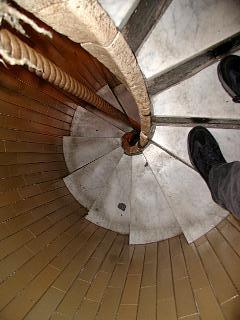 |
But what a sight when you finaly do reach the top! Well worth the effort you get a panoramic view of the entire city! And a surprising crowd, considering the effort involved in getting there.

The walk down required considerably less effort. Afterward, we spent a little more time in the Basilica, and then broke for some lunch.
Our plan had been to visit the Coliseum afterward, but we discovered it closes at six, and we wouldn't have been able to get there until after five. Since our dinner plans were earlier this evening, we opted to head instead directly back to the hotel, and save the Coliseum area (including the Roman Forum) for tomorrow. So we hopped on, hopped off at Piazza Barabrini, and hiked back to the hotel, stopping for a bit at a bookstore for Judie to buy a gift ('The Three Pigs' in Italian) for a friend.
The restaurant Judie selected, Checchino dal 1887, referring to the year it was founded, was in a very south part of town, south actually of both the Coliseum and Circus Maximus, which would give us a chance to try out the subway. The map of Rome's subway is a big 'X', with the center at the main railroad station (called Terminus, appropriately enough), making it trivially easy to navigate. Unfortunately, this does limit the number of places that are close to a station (We never did explore the busses). We lucked out here the restaurant was within 500 meters or so of a station.
The area containing the restaurant was formerly a slaughterhouse district the tour books said "...don't be put off by the general appearance of the area." I'm not sure we were able to comply there, but we did find the restaurant (with some help from the natives), and it turned out to be considerably more upscale than its environs. Despite some confusion with our emailed reservation, we were seated with no hassle, and enjoyed a fine dinner (Or at least I did - Judie was suffering from a sniffle that was doing a pretty thorough job of blocking here taste sense.. As an appetizer, I sampled a native dish made in part from "...boiled and boned veal feet" I thnk it was foreign enough to my palate that really couldn't decided whether I liked it. The balance of them meal was a bit more conventional, and though yummy, did not reach the level of our 'primo' dinner in Florence.
The most interesting part of the evening was a tour of the restaurant's wine cellar. The history of the wine cellar began in about 80 BC, when it was a pile of broken pottery rubble. Apparently, when the Roman potters created a big enough pile of rubble, it was cheaper, for tax reasons, to just move to another location than to clean up the mess (does anything really ever change?). So, this man-made terra cotta hill sat around until the 1400s, when the interior was hollowed out to provide an insulated chamber of fairly uniform temperature year-around (50 degrees at the bottom, 60 at the top), to store olive oil and other perishables. The ancestors of the present owners took it over in 1887 as a wine store; later it became a restaurant to feed the local meat cutters as this is in the slaughterhouse district. Now, its been in the same family for five generations. The cellar's current contents include about 4000 bottles of wine, some reaching into the million-lire range. The owner talked enthusiastically about the business, and the prospects of his sons taking it over in turn, though he did lament about how its pretty much necessary nowadays to have a college degree to be able to understand and deal with all the current government regulations for restauranting.
Given the distance and the hour, we opted to take a taxi back to the hotel. We'd known that there was a surcharge applied to the meter rate after 10:00 PM, but I suspect in our case there may have been an additional surcharge for being a tourist getting picked up at an expensive restaurant. But it was not onerous, so rather than argue about a buck or two, we paid it and turned in for the evening.
I think that once I got past the idea of Rome as a city, I found myself taking to it. Like New York City, it was dirty, noisy, expensive and contained its quota of surly folks. And like New York City, there were things within that made putting up with all that worthwhile.